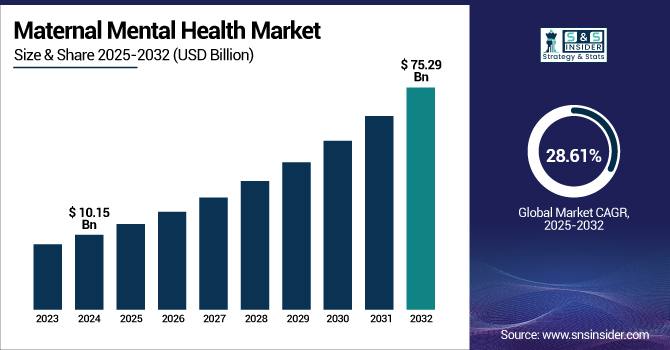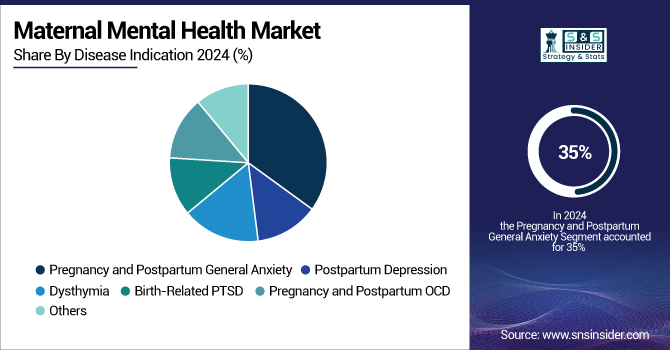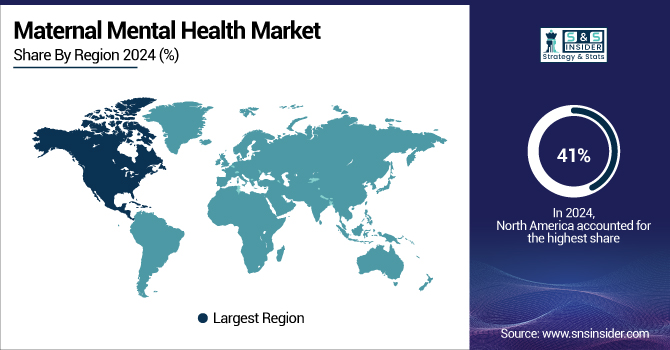Maternal Mental Health Market Report Size Analysis:
The Maternal Mental Health Market size was valued at USD 10.15 billion in 2024 and is expected to reach USD 75.29 billion by 2032, growing at a CAGR of 28.61% over the forecast period of 2025-2032.

To Get more information on Maternal Mental Health Market - Request Free Sample Report
The rising government funding, increasing awareness, and policies to reduce maternal mortality and improve the mental health of mothers have been propelling the growth of the maternal mental health market exponentially. The increasing number of innovations in treatment further propel the market growth.
The U.S. FDA approved zuranolone in 2023, the first oral drug for postpartum depression offering a fast-acting, outpatient solution. Lipocine Inc. is also developing LPCN 1154, which may become the fastest-acting oral therapy for PPD.
These developments reflect growing commitment and opportunity in maternal mental healthcare. Supportive regulatory measures, such as Medicaid expansion under the Affordable Care Act, have also played a key role. Over 38 U.S. states and Washington, D.C., now provide extended postpartum coverage beyond the traditional 60-day limit.
The U.S. maternal mental health market has witnessed significant growth, it’s projected to reach USD 24.24 billion by 2032, growing at a significant CAGR. This rise has also been linked to improved awareness, expanded screening practices, and better access to specialty mental health care for women during and after pregnancy. Mental health conditions and substance use disorders are among the most prevalent pregnancy complications in the United States, with approximately 1 in 5 women affected each year.
The U.S. Department of Health and Human Services is prioritizing maternal mental health with a task force and a national strategy that aims to increase screening, prevention, and access to care. In 2023 alone, 15 states were able to pass new maternal mental health laws, signaling a national commitment to tackle this critical public health issue.
Maternal Mental Health Market Dynamics
Drivers:
-
Increased Awareness of the Postpartum Mental Health to Boosts Early Diagnosis and drive the Market Growth
The growing awareness about postpartum depression (PPD), anxiety, and other perinatal mental health disorders has helped mothers achieve rates of early diagnosis and health-seeking behaviour. Public health campaigns, digital content, and maternal education programs have begun to shatter the stigma that once kept so many women quiet. More and more women are also recognizing symptoms sooner and actively seeking medical attention, therapy, and emotional support.
This trend is being accelerated globally by awareness campaigns organized by NGOs, government health departments, or healthcare providers. Postnatal mental health has lost its taboo status, it’s now addressed more openly in both public and clinical settings.
This has led to an increased need for healthcare providers to recognize and properly manage these ailments. This knowledge tracks with insurers, who are increasingly covering perinatal mental health care. Social media has been used extensively to connect mothers with similar experiences and support groups. These dynamics are driving demand for maternal mental health solutions. Engagement with startups and digital health platforms that provide therapy, mindfulness, and psychological assessment is surging. Celebrities and influencers speaking openly about their postpartum mental health challenges have also given these experiences credibility, which has made it easier for everyday women to own their needs.
Restraints
-
Shortage of qualified maternal mental health professionals hinders maternal mental health market growth
The lack of more trained mental health professionals who can provide care for mothers has created a critical bottleneck to early diagnosis and effective treatment. Yet where the knowledge of perinatal mental disorders is lacking, so are the diagnoses; it remains lost on the majority of women. General practitioners and obstetricians often lack training in this niche area, resulting in underreporting and delayed interventions. In rural and remote areas, the problem becomes even more acute, where access to any form of psychiatric or psychological treatment is sparse or absent altogether. These areas have limited healthcare infrastructure, and often have little or no provision for maternal-focused mental health care. This inability to treat these various populations is exacerbated by the dearth of culturally relevant mental health training. The shortage also affects follow-up care, when patients require long-term counseling and monitoring, which is often in short supply.
Maternal Mental Health Market Segmentation Analysis
By Disease Indication
In 2024, pregnancy and postpartum anxiety held the maternal mental health market share at 35%. This prominence is attributed to the understanding and awareness gained of perinatal mental health issues, which include anxiety disorders. Growth has also been attributed to government initiatives playing an important role.
For instance, the Health Resources and Services Administration (HRSA) within the U.S. Department of Health and Human Services launched the Maternal Mental Health Hotline in May 2022 to assist new mothers with mental health issues, and this line is operational 24/7 to provide support.
Additionally, requested Fiscal Year 2023 Budgetary funding enhanced this service for more staffing and capacity. Further, the Affordable Care Act requires insurance plans to cover preventive services, including screening for maternal depression, at no cost to the patient, thus enabling early identification and intervention. This has greatly supported the much-publicized pregnancy and postpartum anxiety segment in the market.
Meanwhile, the postpartum depression (PPD) segment is projected to grow at the fastest CAGR. The CDC states that about one in eight women in the U.S. report PPD symptoms. Regulatory frameworks such as the Affordable Care Act have strengthened support by mandating insurance coverage for preventive care services such as maternal depression screening. Awareness campaigns and support programs further contribute to the rising demand for maternal mental health services.

By Therapy
The interpersonal psychotherapy (IPT) segment accounted for a significant share of 19% In 2024, and is projected to grow with the fastest annual growth rate during the forecast period. IPT is a brief and focal therapy to improve interpersonal relationships and social functioning to alleviate stress. Most professional bodies, including the American Psychiatric Association and the American College of Obstetricians and Gynecologists, acknowledge its use in the treatment of perinatal mood disorders, including postpartum anxiety and depression. Government backing has improved the general IPT usage.
For example, although the Department of Health and Human Services has stressed evidence-based interventions for maternal mental health, it has also provided access to funds and resources for IPT. These are some of the characteristics of the high market share of IPT.
Maternal Mental Health Market Regional analysis
In 2023, North America dominated the maternal mental health market, accounting for 41% of the global revenue. This is because there are several factors, such as the high prevalence of maternal mental health disorders, healthcare infrastructure, and government initiatives in this area.
For instance, the U.S. launches programs such as the Maternal Mental Health Hotline and extends Medicaid to enable better access to maternal mental care.
In addition, the U.S. Department of Health and Human Services also inaugurated in February 2025 the HHS Secretary's Postpartum Maternal Health Collaborative to improve maternal and child health in rural settings, making its contribution to the region's stronghold in the market.
The U.S. government’s comprehensive national strategy, launched in 2023, promotes maternal mental health as a public health issue. It has led to increased federal funding, wider screening programs, and the establishment of specialized clinics. At the state level, during 2023 alone, 15 states created new maternal mental health laws that opened more doors to care and reduced barriers for underserved populations. Through these policy cases, the market will grow quite fast with a very good rate of diagnosis and treatment.
Asia Pacific is the fastest-growing region with around 29.28% CAGR during the forecast period. This growth is attributed to rising awareness, shifting attitudes toward perinatal mental health, and substantial investments in healthcare infrastructure. Traditionally, stigma and limited resources constrained access to mental health care, but recent years have seen increased government and private sector involvement in establishing specialized services, such as counseling centers and perinatal psychiatric units. The integration of telemedicine and digital health platforms is further improving access, especially in rural and underserved areas.
Europe held a significant share of the maternal mental health market, supported by well-established healthcare systems and comprehensive maternal care policies. The region benefits from ongoing awareness campaigns and government programs aimed at early detection and intervention for maternal mental health disorders. The market is characterized by a high adoption rate of digital health solutions, cross-border collaborations, and the presence of major pharmaceutical and healthcare technology companies.
Recent moves, such as Maven Clinic’s acquisition of Naytal, are expanding the reach of digital maternal mental health services across the continent. Western European countries, particularly the UK, Germany, and France, are leading in both innovation and service provision.
The LAMEA region, encompassing Latin America, the Middle East, and Africa, is experiencing steady growth in the maternal mental health market. In Latin America, the market was driven by increasing awareness and improvements in maternal care services. The Middle East & Africa are driven by the rising demand for comprehensive maternal care, government health initiatives, and the adoption of telemedicine to bridge gaps in access. However, socioeconomic disparities and limited healthcare infrastructure remain challenges, particularly in rural and underserved communities.

Get Customized Report as per Your Business Requirement - Enquiry Now
Maternal Mental Health Market Key Players
Mammha, Seleni Institute, Canopie, LunaJoy, Maternity Foundation, UNFPA, Therapy Mama, Brightside Health Inc., March of Dimes, Viatris Inc., GSK plc, Alembic Pharmaceuticals Limited, Mallinckrodt, Sage Therapeutics, Inc., Bausch Health Companies Inc., Magellan Health, Inc., Pfizer Inc., Eli Lilly and Company
Recent Developments in the Maternal Mental Health Market
-
In Jan 2025, LunaJoy Health raised $4.2M to fund the rollout of LunaCare, an AI-driven maternal mental health program for Medicaid moms, embedding care into current systems.
-
In April 2024, LunaJoy overhauled its clinician certification process with real recordings and AI-simulated cases, with plans to make them accessible for more people and provide CE/CME credits.
-
In February 2023, Biogen Inc. and Sage Therapeutics, Inc. announced that the FDA accepted for filing the New Drug Application for zuranolone, a novel therapy for postpartum depression and major depressive disorder. The application received priority review, with an FDA action date set for August 5, 2023.
| Report Attributes | Details |
|---|---|
| Market Size in 2024 | USD 10.15 Billion |
| Market Size by 2032 | USD 75.29 Billion |
| CAGR | CAGR of 28.6 From 2025 to 2032 |
| Base Year | 2024 |
| Forecast Period | 2025-2032 |
| Historical Data | 2021-2023 |
| Report Scope & Coverage | Market Size, Segments Analysis, Competitive Landscape, Regional Analysis, DROC & SWOT Analysis, Forecast Outlook |
| Key Segments | • By Disease Indication (Postpartum Depression, Dysthymia, Birth-Related PTSD, Pregnancy and Postpartum General Anxiety, Pregnancy and Postpartum OCD, Others), • By Therapy (Antidepressants, Cognitive Behavioral Therapy (CBT), Interpersonal Psychotherapy (IPT), Others) |
| Regional Analysis/Coverage | North America (US, Canada, Mexico), Europe (Germany, France, UK, Italy, Spain, Poland, Turkey, Rest of Europe), Asia Pacific (China, India, Japan, South Korea, Singapore, Australia, Rest of Asia Pacific), Middle East & Africa (UAE, Saudi Arabia, Qatar, South Africa, Rest of Middle East & Africa), Latin America (Brazil, Argentina, Rest of Latin America) |
| Company Profiles | Mammha, Seleni Institute, Canopie, LunaJoy, Maternity Foundation, UNFPA, Therapy Mama, Brightside Health Inc., March of Dimes, Viatris Inc., GSK plc, Alembic Pharmaceuticals Limited, Mallinckrodt, Sage Therapeutics, Inc., Bausch Health Companies Inc., Magellan Health, Inc., Pfizer Inc., AstraZeneca, Eli Lilly and Company, Happify Health. |

